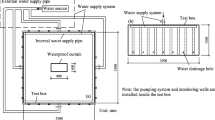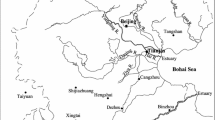Conclusions
-
1.
For the first time in Soviet and world hydraulic engineering practice passage over an earthen slope of a specific discharge of 60 m2/sec with a velocity of 23 m/sec was accomplished during testing of a precast revetment composed of wedge-shaped reinforced-concrete elements with their free stepped placement. Such velocities can be achieved in a rough chute with a bottom slope of 1∶6.5 during passage of specific discharges up to 150 m2/sec.
-
2.
The stepped placement of the revetment elements, the wedge-shaped form of the slabs, and the presence of drainage holes in them produce a hydrodynamic surcharge on the revetment by the flow. The value of the component of all average hydrodynamic loads normal to the slope per unit area is determined by the equation
$$N = \rho gK_o h,$$where π is the density of water; Ko is the surcharge coefficient, which varies from 0.2-to 0.5, depending to the flow regime on the slope, configuration of the slabs, and presence and shape of the drainage holes; h is the depth of water over the revetment; g is the acceleration of gravity. Determination of the flow parameters on a chute-slope having a stepped roughness and the complete calculation of the revetment elements can be accomplished, as was shown earlier, according to [3].
-
3.
The drainage holes in the slabs are located behind the steps lengthwise at a distance of up to 1.5 times the step height but not less than the step height. The total area of the drainage holes in the given section of the slab should be 10–15%. Their preferred shape is round with a diameter not greater than the size of the particles of the upper layer of the filter. Observance of this requirement and the correct selection of the filter protects the structure from removal of the material from under the revetment.
-
4.
To increase the stability of the revetment from uneven settlement of the fill it is recommended to equip its slabs with flexible joints allowing linear and angular movement.
Similar content being viewed by others
Literature Cited
Passage of Floods over Incompletely Constructed Rock-fill Dams (Design Recommendations) [in Russian], VNIIVODGEO, Moscow (1971).
P. I. Gordienko, “Some problems of the design of high earth dams,” in: Hydraulic Structures [in Russian], MISI im. V. V. Kuibysheva, No. 32 (1961).
P. I. Gordienko, “Reinforced-concrete-earth spillways,” in: Dams and Spillways [in Russian], Tr. MISI im. V. V. Kuibysheva, No. 61 (1970).
Yu. P. Pravdivets, “Investigation of the behavior of revetment slabs on earth slopes during flow over the structure,” in: Increasing the Reliability of Hydraulic Structures under Dynamic Loads. Summaries of Reports and Communications [in Russian], VDNKh SSSR, Informénergo, Moscow (1976).
V. S. Serkov et al., Discharge Capacity of Spillways [in Russian], Énergiya, Moscow (1974).
Additional information
Translated from Gidrotekhnicheskoe Stroitel'stvo, No. 4, pp. 22–26, April, 1977.
Rights and permissions
About this article
Cite this article
Grinchuk, A.S., Pravdivets, Y.P. & Shekhtman, N.V. Test of earth slope revetments permitting flow of water at large specific discharges. Hydrotechnical Construction 11, 367–373 (1977). https://doi.org/10.1007/BF02399249
Issue Date:
DOI: https://doi.org/10.1007/BF02399249




